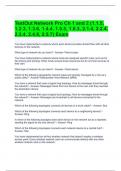Exam (elaborations)
TestOut Network Pro Ch 1 and 2 (1.1.5, 1.2.3, 1.3.6, 1.4.4, 1.5.5, 1.6.3, 2.1.4, 2.2.4, 2.3.4, 2.4.8, 2.5.7) Exam
- Course
- Institution
TestOut Network Pro Ch 1 and 2 (1.1.5, 1.2.3, 1.3.6, 1.4.4, 1.5.5, 1.6.3, 2.1.4, 2.2.4, 2.3.4, 2.4.8, 2.5.7) Exam
[Show more]



